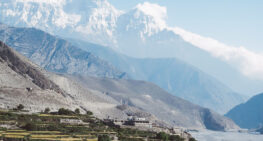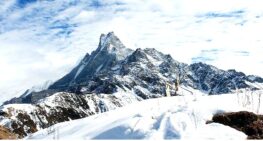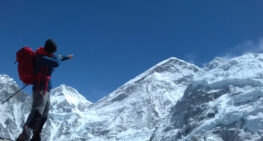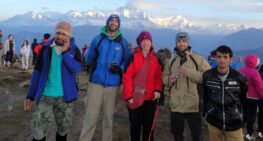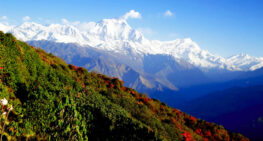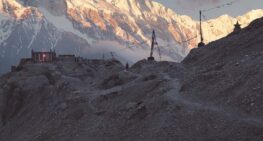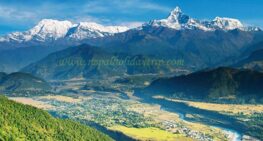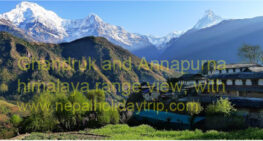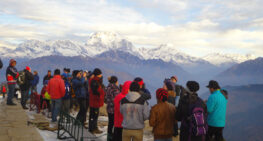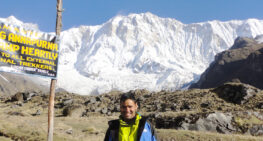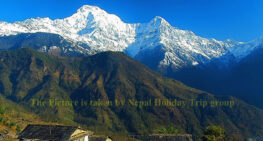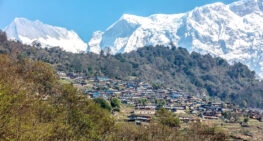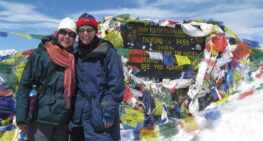Annapurna Sanctuary Trek
The Annapurna Sanctuary trek is a renowned trekking located in the Annapurna Region of Nepal. ABC Trek is located within the larger Himalayas mountain range.
Annapurna Sanctuary trek offers adventures with the chance to practice magnificent natural prettiness, varied landscapes, and a close chance of meeting with the towering peaks of the Annapurna Mountain range.
Annapurna Sanctuary is popular and known as Annapurna Base Camp Trek. This trek typically starts from the lake city Pokhara and leads to lush green forest, terraced fields, Charming villages, and Rhododendrons-filled valleys. As the journey progress, trekkers ascend towards the Annapurna Sanctuary, a stunning glacial basin surrounded by some of the world’s highest peaks including Annapurna I, Annapurna South, Annapurna III, Hiunchuli, and the most attractive mountain Machhapuchre (Fishtail Mountain). Throughout the Annapurna base camp trek, trekkers can experience the cultural richness of the region by interacting with local Communities belonging to various ethnic groups.
Your guide will inform you more while you are in trekking, such as the Gurung and Magars.
The Route clearances through old-style villages, permitting the trekkers to spectator the local way of life, construction, and customs.
The Annapurna Sanctuary trek is known for its miscellaneous terrain, which consists of subtropical forests, bamboo plantations, alpine fields, and eventually the snow-covered landscapes of the high Nepal Himalayas.
The final destination of the trek is the Annapurna Base camp nestled at an altitude of Approximately 4,130 meters 13,549ft.
ABC Trek offers a mesmerizing panoramic view of the surrounding peaks.
Overall, The Annapurna Sanctuary Trek is the perfect choice for both beginner and veteran trekkers.
As you like you can do this trek and some travelers go for peak climbing also. The trek proposes a sensible mix of ordinary beauty and cultural experiences.
Similarly, hiking to Annapurna Sanctuary is challenging terrain.
The cost of the Annapurna Sanctuary Trek will be not much expensive.
This trek gives a chance to observe the Beauty of the Himalayas up close and create last remembrances of an amazing adventure in Nepal Mountain.
Trekking Route of Annapurna Sanctuary Trek
The Annapurna Sanctuary trek is accessible from both Pokhara and Kathmandu. The trek typically starts at Phedi, a few hours’ drive from Pokhara. The route then passes through the terraced hillsides of the Modi Khola valley, the Gurung village of Landruk, and Ghandruk before finally reaching the Sanctuary. The route also passes through enchanting forests of rhododendrons, oak, and pine trees. On the way, trekkers get a chance to see the incredible views of the Annapurna range and the Kali Gandaki River gorge. The Annapurna Sanctuary trek is a great introduction to the world of trekking in the Himalayas and is a must-do for any trekker.
Annapurna Sanctuary Accommodation
On the Annapurna Sanctuary Trek, trekkers can either stay in basic teahouses or camp out. Teahouses are basic mountain lodges that usually offer a bed, a meal, and a hot shower. Camping is also an option, though it is more expensive and is only recommended for more experienced trekkers. The Annapurna Sanctuary is also home to a few meditation retreats, where trekkers can enjoy a peaceful stay while meditating in the beautiful surroundings.
Annapurna Sanctuary Trek Permit cost
The Annapurna Sanctuary Trek requires a permit, which costs around USD 30 if you go through the company. But if you forget to make a permit and the trek starts, the permit fees will be doubled at the checkpoint. The permit is valid for 10 days and can be obtained in Kathmandu or Pokhara. The Annapurna Conservation Area Permit (ACAP) is required to trek in the Annapurna Sanctuary. The permit can be obtained from the Nepal Tourism Board in Kathmandu or Pokhara. Alternatively, trekkers can also hire a trekking agency to obtain the permit on their behalf.
Annapurna Sanctuary Trek Difficulty
The Annapurna Sanctuary Trek is considered to be of moderate difficulty, with some sections requiring mountaineering skills. The trek involves several days of trekking at high altitudes, so it is important to be physically fit. The highest point on the trek is 4,130 m (13,550 ft), so it is important to be well-acclimatized before attempting the trek. It is also important to bring the necessary gear and clothing, as the weather in the Sanctuary can be unpredictable.
Annapurna Sanctuary Trek Itinerary
The Annapurna Sanctuary Trek typically takes about 10-14 days, depending on the route taken and the number of days spent in the Sanctuary itself. The trek usually starts from Phedi or Birethati, a few hours’ drive from Pokhara. The trek then passes through the Modi Khola valley, the Gurung village of Landruk, and Ghandruk before finally reaching the Sanctuary. The trek passes through enchanting forests of rhododendrons, oak, and pine trees and offers incredible views of the Annapurna range and the Kali Gandaki River gorge. The trek ends with a descent to Nayapul, from where trekkers can take a taxi or bus back to Pokhara.
Flora and fauna of Annapurna Region
The Annapurna region is home to a variety of flora and fauna, including the endangered snow leopard and the red panda. The forests of the region are home to many species of trees and plants, including rhododendrons, oaks, pines, magnolias, and orchids. The region is also home to a variety of birds, including the Impeyan pheasant, the Himalayan monal pheasant, and the spiny babbler. The Annapurna region is also home to several species of mammals, including the Himalayan Thar, the Himalayan marmot, and the Himalayan black bear.
Challenges of Annapurna Sanctuary Trek
The Annapurna Sanctuary Trek is strenuous and requires physical preparation and acclimatization. The highest point on the trek is 4,130 m (13,550 ft), so trekkers should be well-acclimatized before attempting the trek. The weather in the Sanctuary can be unpredictable, so it is important to bring the necessary gear and clothing. The terrain can be challenging, so trekkers should have some mountaineering skills. Finally, it is important to be aware of the altitude.
Annapurna Conservation Area
The Annapurna Conservation Area (ACA) is the largest protected area in Nepal, covering an area of 7,629 sq km. The ACA is home to a variety of flora and fauna and is a popular destination for trekkers. The Annapurna Sanctuary Trek is one of the most popular treks in the region and offers stunning views of the Annapurna range.
Varieties of Flowers in Annapurna conservation area
The Annapurna Conservation Area is home to a variety of flowers, including rhododendrons, magnolias, orchids, and blue poppies. The region also has numerous species of wildflowers, including Primula denticulata, Saxifraga ciliaris, and Meconopsis aculeata. The Annapurna Sanctuary Trek is a great opportunity to explore the region’s unique variety of flora.
‘Adventure around picturesque and scenic Annapurna Sanctuary within sweeping mountain panorama’
S. N |
Note: Pokhara extension:
In Pokhara, people with time can join in for a day of adventure sports activities Paragliding-Zip Flyer-Kayaking-Ultra Light flights with cultural and scenic tours of Pokhara at places of interest.Cost Includes
- All transfer airport to Hotel
- Two Night Hotel in Kathmandu with B.B plan
- All Accommodation and three times food during the Trek
- Tourist Bus to Pokhara
- An experienced English speaking Government license holder Trekking Guide
- Two person get one porter
- Guide and porter salary, their food and accommodation in mountain
- All necessary paper work and permit for Annapurna Conservation Area and TIMS
- A comprehensive medical kit-box
- All government and local Taxes
cost excludes
- International and national airfare
- Excess baggage charges
- Lunch and dinner in Kathmandu
- Extra night accommodation in Kathmandu and Pokhara
- Travel Rescue insurance
- Personal expenses like Phone calls, Laundry, Extra drink, Battery charge, Wi-Fi, extra porters, hot and cold water, Hot shower
- Tips for Guide, Porter and Driver, it is mandatory
